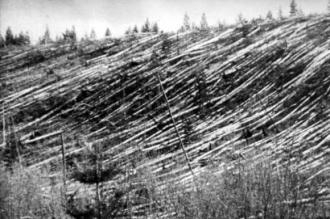 Today is the anniversary of what is known as the Tunguska Event. It is named for the Tunguska river in a very remote area of Siberia. On June 30th 1908, it was the site of a massive explosion. The blast destroyed 830 square miles (2,150 sq km) of forest. It is the largest such event in recorded history and, even now, no one can really agree on what caused it. Luckily it was such a sparsely populated area that no fatalities were reported, and hopefully this is because there weren’t any.
Today is the anniversary of what is known as the Tunguska Event. It is named for the Tunguska river in a very remote area of Siberia. On June 30th 1908, it was the site of a massive explosion. The blast destroyed 830 square miles (2,150 sq km) of forest. It is the largest such event in recorded history and, even now, no one can really agree on what caused it. Luckily it was such a sparsely populated area that no fatalities were reported, and hopefully this is because there weren’t any.
Because it happened in such an isolated place, and because Russia was facing a period of extreme political upheaval at the time, no one visited the area to investigate the cause until 1921. There are a few eyewitness reports of the event. This is what a man named Semyon Borisovich Semyonov had to say when he was interviewed in 1930:
“…the sky split in two and fire appeared high and wide over the forest. The split in the sky grew larger, and the entire northern side was covered with fire. At that moment I became so hot that I couldn’t bear it, as if my shirt was on fire; from the northern side, where the fire was, came strong heat. I wanted to tear off my shirt and throw it down, but then the sky shut closed, and a strong thump sounded, and I was thrown a few metres.”
Among those who witnessed the event, a few said they had seen an object in the sky, To some it was a red fiery ball, to others it seemed to be shaped like a tube and was blue or white in colour. Many agreed that it was too bright to look at. Most people just heard it and described a noise like thunder, or like artillery fire, or falling rocks. The tremors were recorded all over the world. For three days afterwards, glowing clouds were seen in the night sky, so bright that it was possible to read a newspaper, all over Northern Europe. The name for clouds that glow in a dark sky is ‘Noctilucent Clouds’, which is lovely. Here is a picture of some…

The explosion is thought to have been caused either by an exploding meteorite or a comet. Leonid Kulik, the first man to investigate the site, expected to find a huge crater in the middle of the area of devastation, but what he found was a clump of trees that were stripped bare but still standing. For miles around the trees had been knocked down in a direction away from the blast. It seems that what ever caused it had exploded in the air, stripping the trees directly below it, with the force radiating outwards when it hit the ground.
Some mineral samples taken in the area suggest a meteorite, but it is far from conclusive. The lack of any obvious impact sites and the reports of glowing clouds suggest a comet. The glow could have been caused by fragments of dust and ice from the comet in the upper atmosphere catching the sun’s rays. I did find an eyewitness report that claimed a new lake had been formed in the explosion, and that it boiled for two days. But this seems to have been dismissed. However, there is a lake nearby called Lake Cheko which may or may not have been created by a fragment of meteorite. A team of investigators from the University of Bologna believe they have identified a large rock, deep in the lake which may be a piece of the meteorite. They also have evidence from the sediment in the lake that it may be only a hundred years old, but because the area is far from any centre of population, nobody can be certain how long it’s been there.
There are many other explanations on offer. Some suggest that a cloud of natural gas, from under the earth’s crust, may have been forced to the surface and then been ignited by lightening. Others that it was caused by a scientist called Nikola Tesla, who claimed to have invented, and therefore perhaps tested, a weapon that could transmit electricity through the air. Among some of the even crazier theories are a black hole colliding with the earth, an exploding spaceship and a nuclear bomb that somehow travelled back in time and exploded over Siberia. What ever happened, we are incredibly lucky that it did not explode over a major city. St Petersburg, Helsinki, Stockholm and Oslo are all on the same latitude, and could easily have been in the path of a comet, meteorite, spaceship or time-travelling bomb.
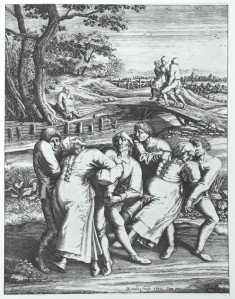 Today is, as I mentioned yesterday, the feast day of Saint John the Baptist but, as I’ve already mentioned that, lets have a look what happened on this day in 1374 in Aachen, Germany. There was a sudden outbreak of Saint John’s Dance. A Dancing Plague was not an uncommon occurrence, there are many instances between the seventh and seventeenth centuries and their true cause is not known. The outbreak in Aachen was a pretty serious one. People began to dance hysterically and also to experience hallucinations. More and more people were drawn in and over the ensuing days thousands were involved. They danced until they were exhausted. They danced until and fell to the ground twitching and foaming at the mouth. Then, they got up and danced again. The plague spread to nearby towns and onwards across Europe for the next two years. The victims certainly were not enjoying their dancing. They were in pain. They often screamed for help and begged for mercy. Dancing Plagues were seen as a curse from Saint John or from Saint Vitus, but we can only guess at why they happened.
Today is, as I mentioned yesterday, the feast day of Saint John the Baptist but, as I’ve already mentioned that, lets have a look what happened on this day in 1374 in Aachen, Germany. There was a sudden outbreak of Saint John’s Dance. A Dancing Plague was not an uncommon occurrence, there are many instances between the seventh and seventeenth centuries and their true cause is not known. The outbreak in Aachen was a pretty serious one. People began to dance hysterically and also to experience hallucinations. More and more people were drawn in and over the ensuing days thousands were involved. They danced until they were exhausted. They danced until and fell to the ground twitching and foaming at the mouth. Then, they got up and danced again. The plague spread to nearby towns and onwards across Europe for the next two years. The victims certainly were not enjoying their dancing. They were in pain. They often screamed for help and begged for mercy. Dancing Plagues were seen as a curse from Saint John or from Saint Vitus, but we can only guess at why they happened.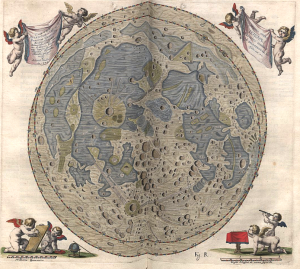 On the 18th June 1178, in Canterbury, just after sunset, five monks were gazing up at the moon when something very unusual happened. No one knows what is was, but it looked like this…
On the 18th June 1178, in Canterbury, just after sunset, five monks were gazing up at the moon when something very unusual happened. No one knows what is was, but it looked like this… The crater was certainly formed relatively recently as the impact marks are still visible on the lunar surface. But in geological terms, recently means any time in the last 350 million years. While 18th June 1178 is certainly a date within the last 350 million years, it is odd that no other historical records anywhere have anything to say about it at all.
The crater was certainly formed relatively recently as the impact marks are still visible on the lunar surface. But in geological terms, recently means any time in the last 350 million years. While 18th June 1178 is certainly a date within the last 350 million years, it is odd that no other historical records anywhere have anything to say about it at all.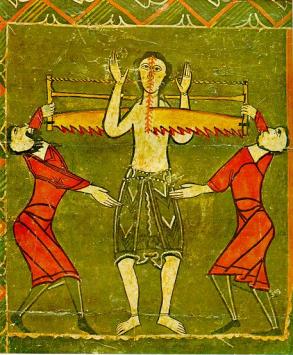 Today is the feast day of Saint Judas Cyriacus, bishop of Ancona, who was martyred in 360 AD. There are loads of saints and some of them have similar names, or even the same name. There is also a Saint Judas Cyriacus, bishop of Jerusalem, who died around 133 AD, who was the great-great grandson of one of Jesus’s brothers. Then the ‘Cyriacus’ part gets variously translated as: Quiriacus, Quiricus, Kyriakos, Ciriaco and Quirico. The picture on the left is the main one on his wikipedia and appears on pretty much every post I’ve seen about him. It’s certainly a good one, but I don’t think it’s him. I think it’s someone completely different from both of them. More of that in a minute though, I’ll tell you about him first.
Today is the feast day of Saint Judas Cyriacus, bishop of Ancona, who was martyred in 360 AD. There are loads of saints and some of them have similar names, or even the same name. There is also a Saint Judas Cyriacus, bishop of Jerusalem, who died around 133 AD, who was the great-great grandson of one of Jesus’s brothers. Then the ‘Cyriacus’ part gets variously translated as: Quiriacus, Quiricus, Kyriakos, Ciriaco and Quirico. The picture on the left is the main one on his wikipedia and appears on pretty much every post I’ve seen about him. It’s certainly a good one, but I don’t think it’s him. I think it’s someone completely different from both of them. More of that in a minute though, I’ll tell you about him first.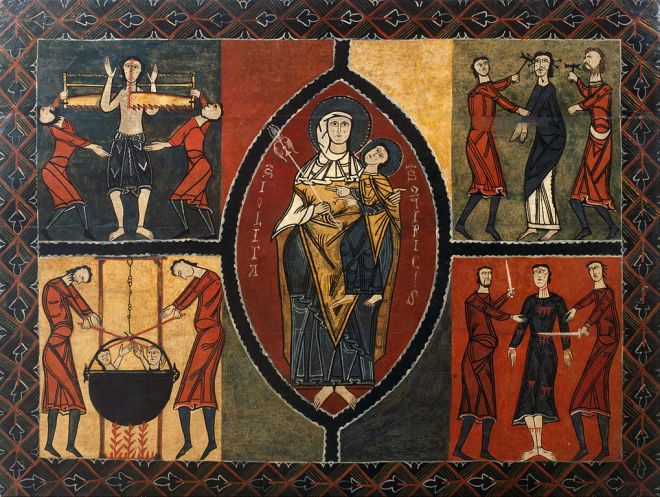
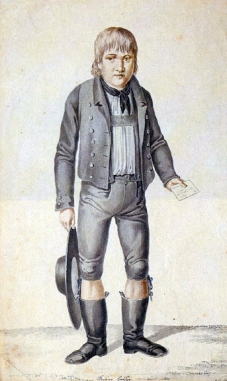 Today might be the birthday of Kasper Hauser. I say ‘might’ because of the great mystery surrounding his sudden appearance in the town of Nuremberg in 1828. The boy carried with him two letters. One addressed to the captain of the 4th squadron of the 6th cavalry regiment, Captain von Wessenig. The anonymous author said that the boy was given into his custody as an infant on October 7th 1812 and that he instructed him in reading, writing and the Christian religion, but never let him “take a single step out of my house”. The letter stated that the boy would now like to be a cavalryman “as his father was” and invited the captain either to take him in or to hang him. The second letter seemed to be from his mother to the person who had written the first. It stated that his name was Kaspar, that he was born on 30 April 1812 and that his father, a cavalryman of the 6th regiment, was dead. Both letters were in the same handwriting and it is now generally supposed that Kasper had written both of them.
Today might be the birthday of Kasper Hauser. I say ‘might’ because of the great mystery surrounding his sudden appearance in the town of Nuremberg in 1828. The boy carried with him two letters. One addressed to the captain of the 4th squadron of the 6th cavalry regiment, Captain von Wessenig. The anonymous author said that the boy was given into his custody as an infant on October 7th 1812 and that he instructed him in reading, writing and the Christian religion, but never let him “take a single step out of my house”. The letter stated that the boy would now like to be a cavalryman “as his father was” and invited the captain either to take him in or to hang him. The second letter seemed to be from his mother to the person who had written the first. It stated that his name was Kaspar, that he was born on 30 April 1812 and that his father, a cavalryman of the 6th regiment, was dead. Both letters were in the same handwriting and it is now generally supposed that Kasper had written both of them.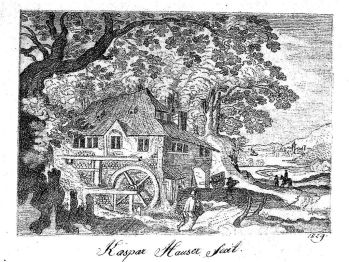 Kasper was given into the care of a schoolmaster called Georg Friedrich Daumer, who found out that he had a talent for drawing. That’s one of Kasper’s drawings on the left. Daumer also conducted some odd experiments on him, including some sort of magnetic experiments. Some believed, at that time, that the body was full of magnetic humours that could be drawn about to some effect, but more of that next month when it will be Franz Mesmer’s birthday. Kasper claimed that the north pole of the magnet made him feel as though his stomach was being drawn out and that he could feel a current of air coming from him. The effects of the south pole, he felt less keenly, but said that it blew upon him.
Kasper was given into the care of a schoolmaster called Georg Friedrich Daumer, who found out that he had a talent for drawing. That’s one of Kasper’s drawings on the left. Daumer also conducted some odd experiments on him, including some sort of magnetic experiments. Some believed, at that time, that the body was full of magnetic humours that could be drawn about to some effect, but more of that next month when it will be Franz Mesmer’s birthday. Kasper claimed that the north pole of the magnet made him feel as though his stomach was being drawn out and that he could feel a current of air coming from him. The effects of the south pole, he felt less keenly, but said that it blew upon him.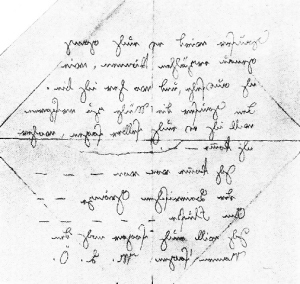 The note was folded into a triangular shape, in a way that Kasper always folded his own letters. It also contained one grammatical and one spelling error that were typical of him. Also, although he seemed keen for the purse to be found, he never asked what was in it.
The note was folded into a triangular shape, in a way that Kasper always folded his own letters. It also contained one grammatical and one spelling error that were typical of him. Also, although he seemed keen for the purse to be found, he never asked what was in it.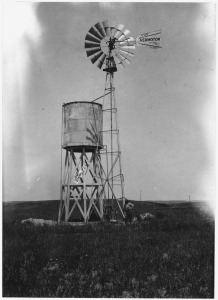 I have a mystery to tell you about today. On this day in 1897, a UFO crash landed in Aurora, Texas. Or did it? It is claimed that the crash caused one fatality… the pilot. There is supposed to be an alien body buried in the local churchyard.
I have a mystery to tell you about today. On this day in 1897, a UFO crash landed in Aurora, Texas. Or did it? It is claimed that the crash caused one fatality… the pilot. There is supposed to be an alien body buried in the local churchyard.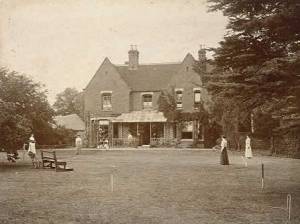 Winter is almost over and the days are definitely getting a bit longer here. Soon, I’ll be able to look forward to getting home from work before sunset. But, until then, maybe there’s time for just one more ghost story. Today, I want to tell you about Borley Rectory in Essex, a Victorian mansion that was built in 1862. It was built to replace a previous rectory that had burned down in 1841. Borley Rectory became famous as the ‘most haunted house in England’. On this day in 1936, it was destroyed by a fire.
Winter is almost over and the days are definitely getting a bit longer here. Soon, I’ll be able to look forward to getting home from work before sunset. But, until then, maybe there’s time for just one more ghost story. Today, I want to tell you about Borley Rectory in Essex, a Victorian mansion that was built in 1862. It was built to replace a previous rectory that had burned down in 1841. Borley Rectory became famous as the ‘most haunted house in England’. On this day in 1936, it was destroyed by a fire.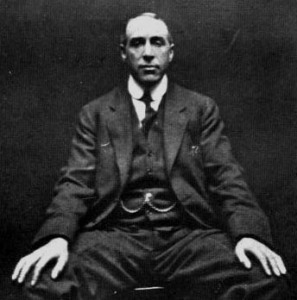 horse-drawn carriage. In 1929, the couple wrote to a newspaper called the Daily Mirror about their experiences and asked to be put in touch with the Society for Psychical Research. They sent a reporter and also arranged for a psychical researcher called Harry Price to visit them. As soon as he arrived, new phenomena appeared. Stones were thrown and spirit messages were tapped out on the frame of a mirror. These sort of occurrences ceased as soon as Harry left the property. The Smiths left Borley about a month later.
horse-drawn carriage. In 1929, the couple wrote to a newspaper called the Daily Mirror about their experiences and asked to be put in touch with the Society for Psychical Research. They sent a reporter and also arranged for a psychical researcher called Harry Price to visit them. As soon as he arrived, new phenomena appeared. Stones were thrown and spirit messages were tapped out on the frame of a mirror. These sort of occurrences ceased as soon as Harry left the property. The Smiths left Borley about a month later.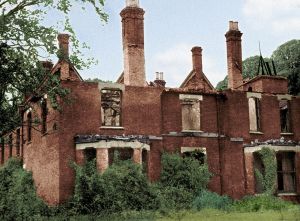 On February 27th 1939, the new owner of the Rectory, Captain W H Gregson was unpacking some boxes in the hall when he upset a lighted oil lamp. The fire spread quickly and the house was badly damaged. Insurance investigators concluded that the fire had been started deliberately. A local woman claimed to have seen the nun looking out of one of the building’s upper floor windows during the fire. The house was left a ruin. In 1943, Harry Price returned and conducted a dig in the cellar of the rectory. He found two bones supposed to be that of a young woman. They were buried, with ceremony, in a churchyard, but not at Borley. They refused the remains because they believed them to be the bones of a pig.
On February 27th 1939, the new owner of the Rectory, Captain W H Gregson was unpacking some boxes in the hall when he upset a lighted oil lamp. The fire spread quickly and the house was badly damaged. Insurance investigators concluded that the fire had been started deliberately. A local woman claimed to have seen the nun looking out of one of the building’s upper floor windows during the fire. The house was left a ruin. In 1943, Harry Price returned and conducted a dig in the cellar of the rectory. He found two bones supposed to be that of a young woman. They were buried, with ceremony, in a churchyard, but not at Borley. They refused the remains because they believed them to be the bones of a pig.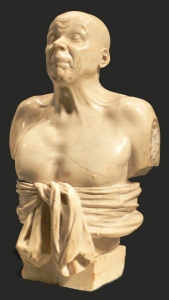 Today is the birthday of sculptor Franz Xaver Messerschmidt, who was born is 1736 in Wiesensteig in the south west of Germany. He is best known for a series of head sculptures which all depict extreme and rather disturbing facial expressions. He was raised in Munich by his uncles and it was from them that he first learned sculpture. After that he went to study at the Academy of Fine Arts in Vienna. Messerschmidt was extremely good with the current, flamboyant baroque style, he earned lots of commissions and became Court Sculptor the the royal house of Habsburg.
Today is the birthday of sculptor Franz Xaver Messerschmidt, who was born is 1736 in Wiesensteig in the south west of Germany. He is best known for a series of head sculptures which all depict extreme and rather disturbing facial expressions. He was raised in Munich by his uncles and it was from them that he first learned sculpture. After that he went to study at the Academy of Fine Arts in Vienna. Messerschmidt was extremely good with the current, flamboyant baroque style, he earned lots of commissions and became Court Sculptor the the royal house of Habsburg.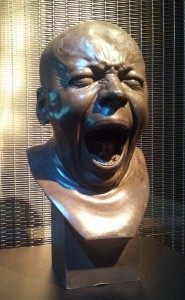 The accusations were rather veiled and non-specific but we know that in 1771 he had begun to work on a series of heads. The head sculptures are mostly life-size, are probably all of him and show a range of extreme facial expressions. Many of them look as though they are in severe pain. It was a project that would consume him for the rest of his life. He would make sixty-four of them. He still continued to support himself with commissions that people were perfectly happy with, so he was not entirely unhinged. But his heads are very odd indeed. They’re not like anything else.
The accusations were rather veiled and non-specific but we know that in 1771 he had begun to work on a series of heads. The head sculptures are mostly life-size, are probably all of him and show a range of extreme facial expressions. Many of them look as though they are in severe pain. It was a project that would consume him for the rest of his life. He would make sixty-four of them. He still continued to support himself with commissions that people were perfectly happy with, so he was not entirely unhinged. But his heads are very odd indeed. They’re not like anything else.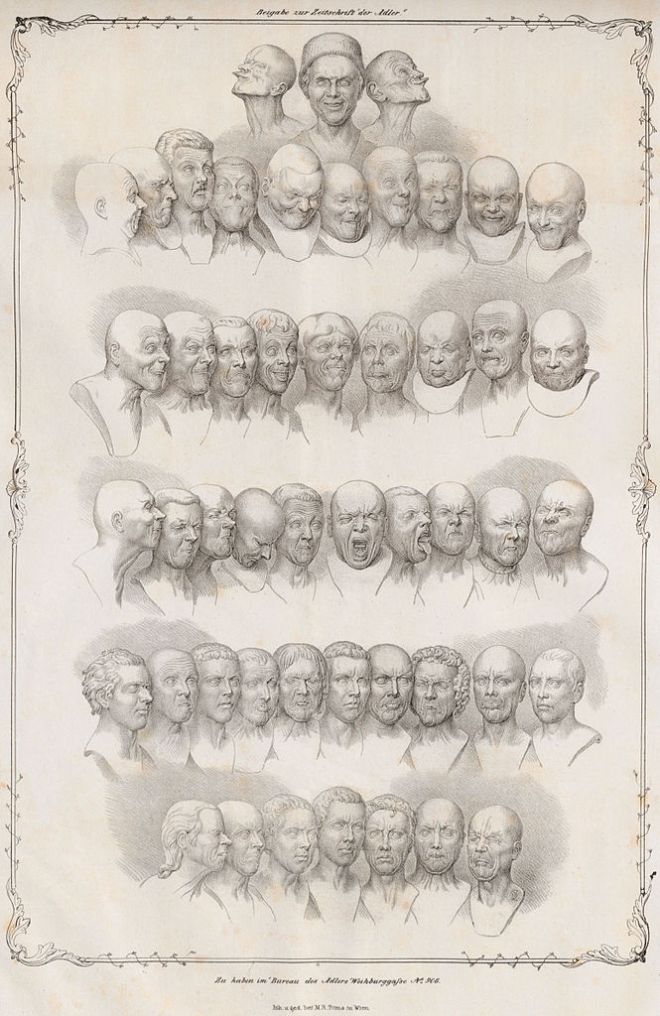
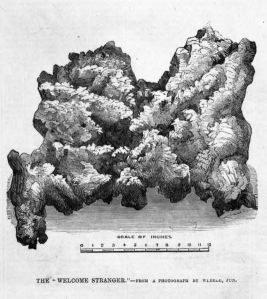 Today I want to tell you about a gold nugget that was found in Moliagul, Victoria in Australia on February 5th 1869. It was discovered by Cornish tin miners John Deason and Richard Oates and it is the largest nugget ever found. A nugget sounds like something small, like a booklet or a piglet, this was more of a ‘nug’. It was around 21 inches long and 10 inches thick. John and Richard were probably part time prospectors who spent the rest of their time farming their bit of land in Moliagul. They had moved there in 1862. It was a sparsely populated area, but nine years earlier there had been a rush which saw around five hundred people camping out in tents and looking for gold. During the 1850s and 60s, a vast amount of gold was discovered in the Victorian Gold Fields. One thousand tons is the total recorded estimate, though the true figure is probably twice that because some people preferred to keep their finds to themselves. Large nuggets were not uncommon, but the 1853 prospectors missed a bit.
Today I want to tell you about a gold nugget that was found in Moliagul, Victoria in Australia on February 5th 1869. It was discovered by Cornish tin miners John Deason and Richard Oates and it is the largest nugget ever found. A nugget sounds like something small, like a booklet or a piglet, this was more of a ‘nug’. It was around 21 inches long and 10 inches thick. John and Richard were probably part time prospectors who spent the rest of their time farming their bit of land in Moliagul. They had moved there in 1862. It was a sparsely populated area, but nine years earlier there had been a rush which saw around five hundred people camping out in tents and looking for gold. During the 1850s and 60s, a vast amount of gold was discovered in the Victorian Gold Fields. One thousand tons is the total recorded estimate, though the true figure is probably twice that because some people preferred to keep their finds to themselves. Large nuggets were not uncommon, but the 1853 prospectors missed a bit.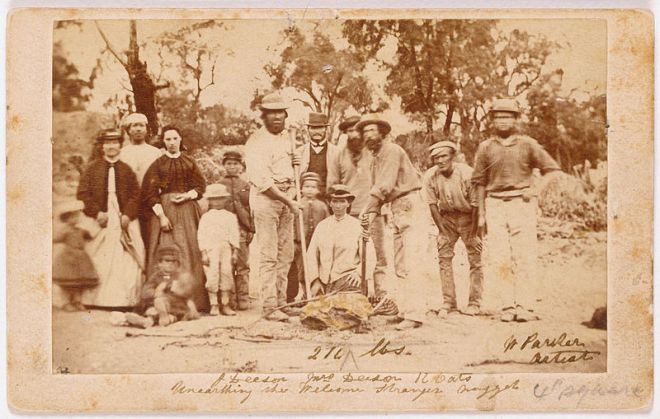 When they got it out of the ground, they found it had quartz in it that was also flecked with gold. It weighed around three hundredweight. Unfortunately it was a Friday afternoon, the bank was closed and they had no choice but to keep it in their house over the weekend. During that time, they managed to keep their discovery a secret but also, by repeatedly heating the nugget on the fire and then cooling it, they managed to break off 72lb of quartz. On Monday, they took the quartz to be crushed and retrieved 60 oz of gold from it. On Tuesday, they and a few friends took it all to the bank in their wagon, hidden under the skirts of Mrs Deason. They were advised to take it to Melbourne, but it was a long way so they decided it was safer to take it to a nearby bank in Dunolly. Deason asked the manager what his price for gold was by hundredweight. The manager gave him the price per ounce. He said no, he wanted the price by hundredweight. The manager sent him away because he thought he was drunk. He returned shortly with his hundredweights of gold and laid it out on the floor to show the shocked bank manager. The scales at the bank were not big enough to weigh it. They had to put it in a wheelbarrow and take it to a blacksmith to be broken up. The total weight of the nugget was 210lb Troy, Within five hours, the whole thing was smelted down and made into ingots. It was found to be 98.61% pure. Most of it was sold to the bank for the sum of £9,000, though they did keep a little for themselves and their friends. The ingots were shipped off to the Bank of England.
When they got it out of the ground, they found it had quartz in it that was also flecked with gold. It weighed around three hundredweight. Unfortunately it was a Friday afternoon, the bank was closed and they had no choice but to keep it in their house over the weekend. During that time, they managed to keep their discovery a secret but also, by repeatedly heating the nugget on the fire and then cooling it, they managed to break off 72lb of quartz. On Monday, they took the quartz to be crushed and retrieved 60 oz of gold from it. On Tuesday, they and a few friends took it all to the bank in their wagon, hidden under the skirts of Mrs Deason. They were advised to take it to Melbourne, but it was a long way so they decided it was safer to take it to a nearby bank in Dunolly. Deason asked the manager what his price for gold was by hundredweight. The manager gave him the price per ounce. He said no, he wanted the price by hundredweight. The manager sent him away because he thought he was drunk. He returned shortly with his hundredweights of gold and laid it out on the floor to show the shocked bank manager. The scales at the bank were not big enough to weigh it. They had to put it in a wheelbarrow and take it to a blacksmith to be broken up. The total weight of the nugget was 210lb Troy, Within five hours, the whole thing was smelted down and made into ingots. It was found to be 98.61% pure. Most of it was sold to the bank for the sum of £9,000, though they did keep a little for themselves and their friends. The ingots were shipped off to the Bank of England.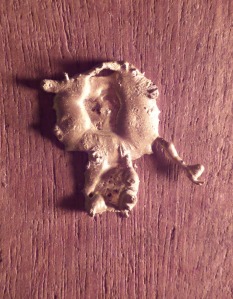
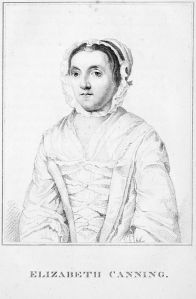 Today I have an unsolved mystery to tell you about. At around 10 pm on January 29th 1753, eighteen-year-old Elizabeth Canning turned up at her mother’s house at Aldermanbury in the City of London. She had been missing since the night of January 1st. Her face and hands were black with dirt, she was wearing only a shift, a petticoat and a bedgown. Around her head, was wrapped a filthy rag that was soaked in blood from a wound on her ear. Her mother fainted.
Today I have an unsolved mystery to tell you about. At around 10 pm on January 29th 1753, eighteen-year-old Elizabeth Canning turned up at her mother’s house at Aldermanbury in the City of London. She had been missing since the night of January 1st. Her face and hands were black with dirt, she was wearing only a shift, a petticoat and a bedgown. Around her head, was wrapped a filthy rag that was soaked in blood from a wound on her ear. Her mother fainted.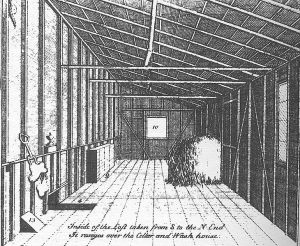 Mrs Canning’s house was soon filled with concerned neighbours but Elizabeth was, at first, unable to speak. She was attended by an apothecary and when she recovered a little, she told everyone what had happened. On her way home she had been attacked by two men near the Bedlam Hospital. They had robbed her, partially stripped her of her clothes and then hit her across the temple rendering her unconscious. She had awoken, still with the two men, but beside a large road where there was water. They had made her walk to a house where an old woman asked her if she would ‘go their way’, by which she meant become a prostitute. When Elizabeth refused, the woman had cut off her corset, slapped her face and pushed her upstairs into the loft. She had remained there until January 29th. She had spoken to no one, but thought she heard the name ‘Wills’ or ‘Wells’. She had been given only bread and water and had scavenged the clothes she was wearing from a fireplace in the loft. The loft’s only window was boarded over but she had been able to see, in the yard, a coachman she thought she recognised and guessed that she was on Hertford Road. She had made her escape by prying the boards away from the window and jumping out.
Mrs Canning’s house was soon filled with concerned neighbours but Elizabeth was, at first, unable to speak. She was attended by an apothecary and when she recovered a little, she told everyone what had happened. On her way home she had been attacked by two men near the Bedlam Hospital. They had robbed her, partially stripped her of her clothes and then hit her across the temple rendering her unconscious. She had awoken, still with the two men, but beside a large road where there was water. They had made her walk to a house where an old woman asked her if she would ‘go their way’, by which she meant become a prostitute. When Elizabeth refused, the woman had cut off her corset, slapped her face and pushed her upstairs into the loft. She had remained there until January 29th. She had spoken to no one, but thought she heard the name ‘Wills’ or ‘Wells’. She had been given only bread and water and had scavenged the clothes she was wearing from a fireplace in the loft. The loft’s only window was boarded over but she had been able to see, in the yard, a coachman she thought she recognised and guessed that she was on Hertford Road. She had made her escape by prying the boards away from the window and jumping out.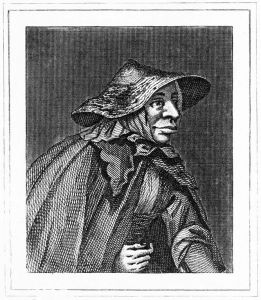 Elizabeth was very much perceived as the wronged party and received a great deal of support. The trial was huge, press coverage was massive. It involved the novelist Henry Fielding, who was then a magistrate. Support was very much in favour of Elizabeth who appeared to be, and perhaps was, an innocent young woman. Imprisoned after refusing a life of prostitution by a person who the press portrayed as an ugly old gypsy. Pamphlets were published (there were always pamphlets in the eighteenth century – think of them as twitter, but before the internet and considerably more verbose), public subscriptions were raised to help her with her case. Eighteenth century law bore little regard for an individual’s personal safety and it was rather chilling to find out that Mary Squires was not charged with either assault or kidnapping, but the theft of a corset, which was worth ten shillings. It was a crime that, if guilty, was punishable by hanging. Both Wells and Squires denied having ever seen Elizabeth before she came to the house with the warrant officer. Elizabeth Canning’s supporters behaved appallingly at the trial. There were several people willing to speak on behalf of Mary Squires, but all save three were prevented from attending by a mob outside the Old Bailey. They wanted to testify that Mary, a lady who travelled about, selling bits and pieces, had been nowhere near Enfield Wash on January 1st. Susannah Wells said the same. The three men who did make it through were beaten up by the crowd as they left.
Elizabeth was very much perceived as the wronged party and received a great deal of support. The trial was huge, press coverage was massive. It involved the novelist Henry Fielding, who was then a magistrate. Support was very much in favour of Elizabeth who appeared to be, and perhaps was, an innocent young woman. Imprisoned after refusing a life of prostitution by a person who the press portrayed as an ugly old gypsy. Pamphlets were published (there were always pamphlets in the eighteenth century – think of them as twitter, but before the internet and considerably more verbose), public subscriptions were raised to help her with her case. Eighteenth century law bore little regard for an individual’s personal safety and it was rather chilling to find out that Mary Squires was not charged with either assault or kidnapping, but the theft of a corset, which was worth ten shillings. It was a crime that, if guilty, was punishable by hanging. Both Wells and Squires denied having ever seen Elizabeth before she came to the house with the warrant officer. Elizabeth Canning’s supporters behaved appallingly at the trial. There were several people willing to speak on behalf of Mary Squires, but all save three were prevented from attending by a mob outside the Old Bailey. They wanted to testify that Mary, a lady who travelled about, selling bits and pieces, had been nowhere near Enfield Wash on January 1st. Susannah Wells said the same. The three men who did make it through were beaten up by the crowd as they left.